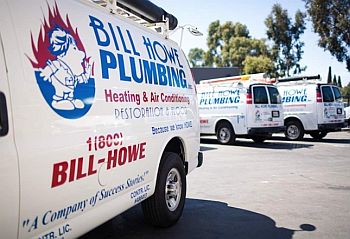
Dramatic reduction in accidents, reduced fuel consumption, increase in productivity
By Mark Boada, Executive Editor
Ask Rhett Wheeler, operations risk manager who doubles as the fleet manager for Bill Howe Plumbing, Inc. in San Diego, what kind of return the company has enjoyed from its investment in telematics and he’ll tell you this: “We haven’t calculated the precise numbers, but with our accident reduction, fuel savings and improvement in productivity, it’s got to be 100 to one.”
In 2016, the year before Wheeler joined the company, its fleet of 130 vehicles suffered 16 accidents – mostly rear-enders in stop and go traffic – that cost it $1 million in damages to its own and second-party vehicles. Wheeler came to Bill Howe near the start 2017 after 15 years managing some 300 Domino’s Pizza delivery drivers, and quickly made accident reduction one of his top priorities.
His solution: to install a new telematics system from Verizon Connect. The result: over the following 12 months, the fleet – now grown to 160 pickups, vans and box trucks – suffered only two accidents, with total damages under $10,000, while covering more than 4 million miles. That’s an 83 percent reduction in the fleet’s accident rate, and Wheeler credits the Verizon system, which replaced another provider’s, as the single most important contributor to those results. To be fair to Wheeler, it’s also about what he does with information and how he interacts with his drivers.
Like every other telematics system, the previous one Howe employed and Verizon’s both provide real-time data on the incidence of driving safety events like speeding, jack-rabbit starts, and hard braking and cornering. Wheeler said the advantage of Verizon’s over the system it replaced is its ability to provide the exact time and location where every incident occurs. That, combined with daily emails and weekly summary reports every driver receives on his or her incidents, has been the main lever in changing the company’s driver behavior.
“Our previous system had trouble giving us the location of events,” he said. “You can tell a driver he or she had such and such speeding events or hard braking events, but without showing them when and where they happened, they can just say, ‘That wasn’t me.’ But show them the extra information, and then they say, ‘Oh, yeah, I remember doing that there,’ and then you can get them to change the way they drive.”
The emails are just one way that Wheeler reaches out to offending drivers. He meets one-on-one with the most serious offenders, but he also posts drivers’ scores on a company bulletin board for all drivers to see. The result is some friendly competition and peer pressure for drivers to achieve a higher, safer score. “They’ll look at the scores,” Wheeler said, “and they’ll say, ‘Ooh, I had a better week than you did.’ It gives them bragging rights.”
Beyond that are the company’s monthly classroom safety meetings, and Wheeler’s daily morning one-on-one safety chats with drivers when they show up for work. The crowning elements in his fleet safety program are the fleet’s semi-annual MVR checks and participation in the California system that reports when something new is added to a driver’s MVR.
But a couple other great results came with Verizon’s telematics system: reduced idling and greater driver productivity. These have come about through the system’s ability to report each driver’s idle time, where they spend their time between jobs and how long, and how often during the week they come back to the office to pick up parts.
“Verizon Connect was showing me the hangouts where drivers were spending too much time eating snacks or lunch,” Wheeler said, which enabled him to crack down on drivers. “Productivity factors into technician’s paycheck, so when a guy complains that his paycheck is lower than the last one, I can say, ‘Well, if you didn’t spend so much time at the convenience store, it might be higher.” Wheeler is also able to identify drivers who don’t stay on top of the parts inventory in their service vehicles and encourage them do better to avoid needless trips.
As a result of the ways in which he’s able to monitor driver behavior, Wheeler said his fleet has been able to reduce its fuel consumption by as much as 40 percent, and that its technicians have increased the average number of plumbing and heating customers they call on per day from 125 to 200.
Wheeler notes that when he first installed the Verizon Connect system, drivers gave him some push back.
“A lot of the guys at the beginning had this Big Brother issue, where they thought that Big Brother was watching them, and that I’m going to harp on them for every little thing. So, they did some cute stuff like unplugging the telematics device. But I did lot of coaching to tell them, ‘Hey, that’s not the intent.’
“Now, almost a year and a half later, the guys don’t even realize it’s there any more, it’s just part of life. It’s not a Big Brother thing anymore, it’s just is what it is. I tell them we’re deeply invested in our employees and want them to have long careers with us; that our telematics program is our way of helping them take care of themselves and their families, and that getting them home to their families safely every night is really our number priority.”
Sounds like a win-win proposition that has had tremendous success all-around.
The post Seeking Accident Reduction, San Diego Plumbing Fleet Hits It Big With Its New Telematics System appeared first on Fleet Management Weekly.
from Fleet Management Weekly https://ift.tt/2zMdPew



Sourced by Quik DMV - CADMV fleet registration services. Renew your registration online in only 10 minutes. No DMV visits, no lines, no phone mazes, and no appointments needed. Visit Quik, Click, Pay & Print your registration from home or any local print shop.





0 comments:
Post a Comment